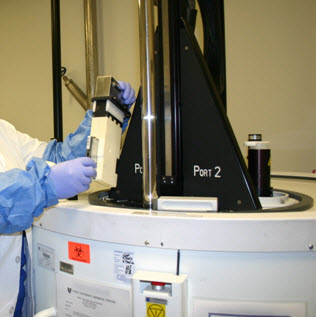Storing Cord Blood

After processing, eligible cord blood units are frozen (cryopreserved) and stored under liquid nitrogen in robotic freezers that are monitored 24 hours a day. Cryopreservation must take place within 48 hours from collection.
After the unit is cryopreserved, CCBB reviews all testing from the cord blood unit and from the maternal blood samples and determines if the unit meets specifications for banking. If the cord blood unit is considered eligible for banking, the information about the cord blood unit is listed on the National Marrow Donor Program’s Be the Match® Registry where it can be accessed by transplant programs from around the world. The cord blood unit is de-identified, i.e. no personal, identifiable patient information is listed in the registry.
Cord blood units can be stored for at least 2 decades, and perhaps longer. Studies are ongoing to determine if cord blood units expire after long term storage. To date, there is no evidence that cells lose potency over time if they are stored under liquid nitrogen.
